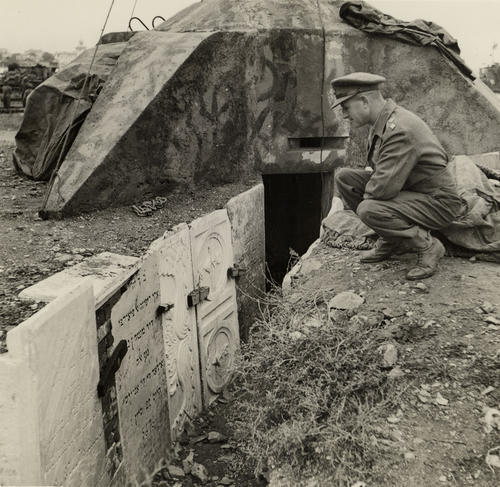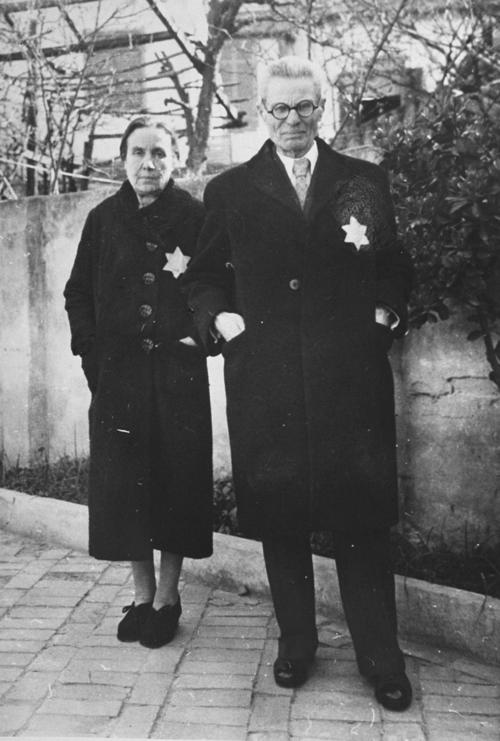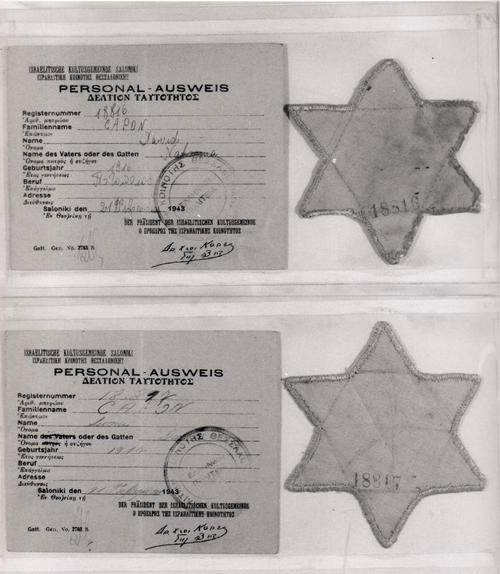Holocaust
Official British photograph showing a british soldier staring at descrated Jewish tombstones in Thessaloniki. United States Holocaust Memorial Museum Photo Archives
A Jewish couple wearing the yellow star poses on a street in Thessaloniki. Pictured are Rachel and Joseph Chasid, the parents of Margo (Chasid) Melech. United States Holocaust Memorial Museum Photo Archives
The yellow star. Collection of the Jewish Museum of Greece
The deportation and annihliation of Greek Jews, as part of the Nazi plan for the extermination of all the European Jews, was carried out from early 1943 until the summer of 1944. Totally, 58,886 Greek Jews from a total population of 71,611 souls (pre-war population) were murdered in the death camps, a destruction rate that exceeds 85%, one of the highest percentages in Europe.
The Jewish presence in Greece had been, until the Holocaust, more diverse than in any other European country because of its different cultural backgrounds. By far the largest community was the one of Thessaloniki. In 1941, the second largest greek city was one of the major centers of Sephardic Jewry, with a population of 56.000 Jews, descendants of the expellees from Spain that had found shelter in the Ottoman Empire at the end of the 15th Century. The city had 35 synagogues, eight Jewish schools, two Jewish orphanages and numerous libraries, amounting to a property of 56 Millions Marks. In 1943, as many as 45.000 Jews from Thessaloniki were deported to Auschwitz-Birkenau. After the war, only 1,950 Jews were counted in Thessaloniki—96% percent perished. At the same time, the world’s largest Jewish cemetery, with 500,000 graves, was destroyed by the municipal authorities in Thessaloniki. The city and its citizens used the tombs marble as building material for decades. The Aristotle University was built on the desecrated site. Between March and August 1944, 8.000 Jews from the remaining communities, including the Romaniotes of Ioannina and the isolated island communities of Rhodes, Kos, Corfu and Kreta, were also arrested and deported to Auschwitz. An equal number survived in hiding or by fleeing to the Middle East or to various partisan-controlled territories.
Despite the fact that Holocaust took such a heavy toll on Greek Jewry, public awareness hardly connects the Shoah with Greece, while the facts were until very recently virtually nonexistent in public commemoration. In the 1980s, the history of the Greek Jews, and especially their destruction, was still not a part of the national narrative. The first book on the genocide of the Greek Jews, first published in 1974, comes from two scholars of the Jewish community of Thessaloniki. The title is dedicated to the memory of the victims: In Memoriam (Molho, Nehama). Greece couldn't reach the level of the Holocaust studies in West Europe, as it had to prioritize other public history debates, such as Resistance and Collaboration.



